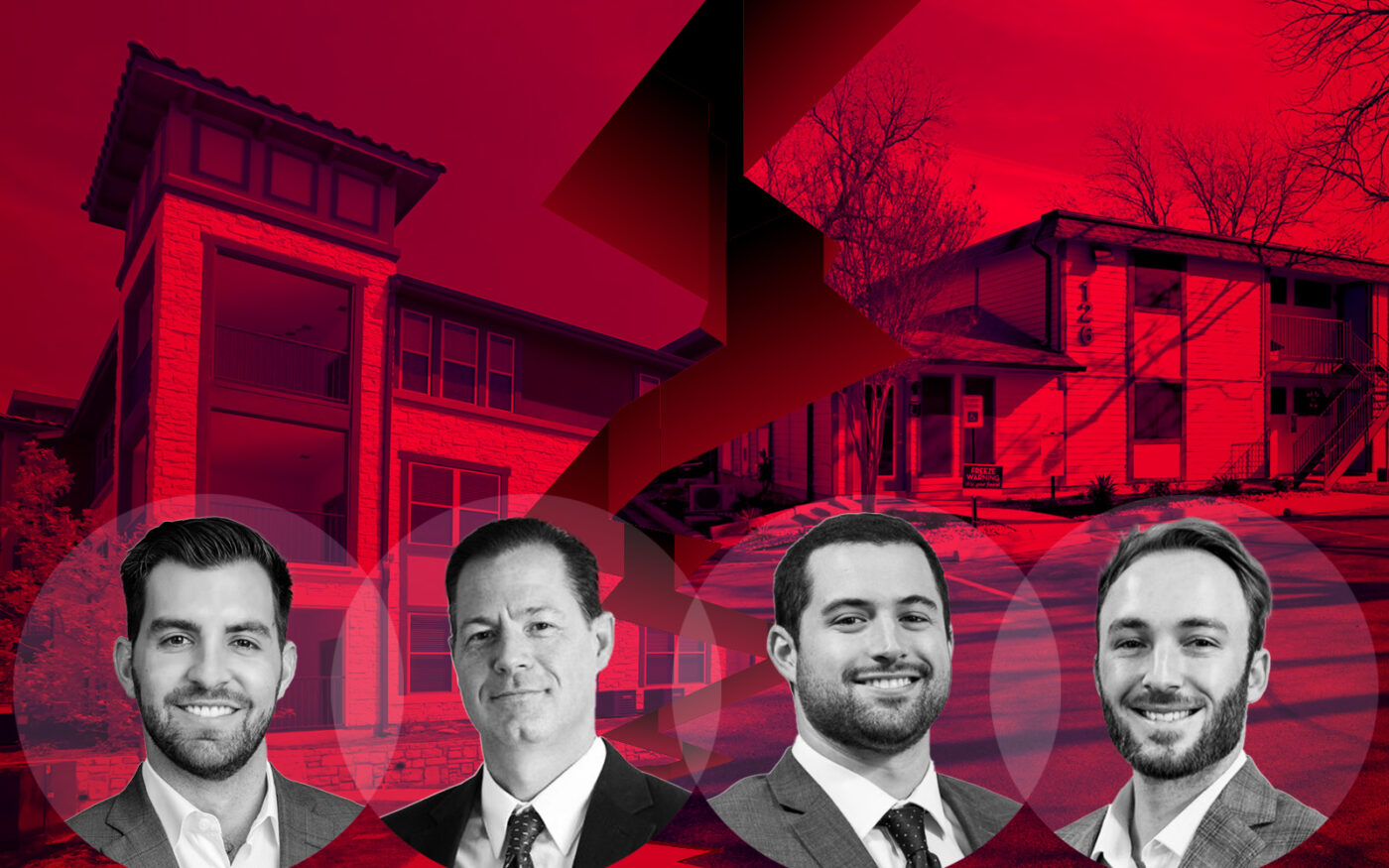For the past few years, Texas multifamily was one of the hottest real estate investments in the country.
Not anymore.
Industry players think the trouble has only just begun, and that might be a lagging assessment. Plenty of properties already are being sold at major discounts, and once-mighty development pipelines are all but dead is some cities.
No segment of the asset class is safe. A deluge of Class A apartments will come online in the next 18 months, giving developers little power over pricing. At the same time, they will need to scramble to fill apartments so they can refinance their construction loans or sell before they mature.
Meanwhile, many of the Class B and Class C value-add properties that were bought for record prices in 2021 and 2022 have seen major declines in values. Heightened renovation costs and falling rents have complicated value-add plays, all while owners are being forced to replace expiring rate caps and refinance into more expensive debt.
There will be winners, particularly those with enough cash to weather the short-term. But there will also be losers: scores of small developers, syndicators and Main Street investors are now staring down a massacre in the Lone Star state.
Pipeline problems
The picture in Texas multifamily has changed so severely that the recent past sounds like a totally different era.
During the pandemic, Texas’ major metros built up some of the biggest development pipelines in the country.
In Dallas-Fort Worth, the most populous of the Texas Triangle metros, about 63,350 units are in the pipeline right now, according to a recent report from commercial real estate firm Partners. For each of the three previous three years, that number has been closer to 49,000. This year, 23,662 units have already been delivered, double the 11,707 units delivered at this point last year.
Deliveries have tripled in San Antonio and increased by 76 percent in Austin. New apartments are still being absorbed at a steady clip, but occupancy has ticked down to below 90 percent in Austin and San Antonio.
Steve Triolet, a research and market forecasting expert at Partners, considers a 10 percent vacancy rate to be the breaking point where tenants gain the upper hand in a market.
“They built so much in such a short time window,” Triolet said. “All the Texas markets now are in between neutral and tenant-favorable conditions, where a year and a half ago, all were landlord favorable.”
Landlords are in a vise — on one end, they’ve lost pricing power due to the enormous amount of similar, newly built projects flooding the market. On the other, many of the construction loans that funded their developments are maturing. Developers can either sell their projects or refinance them, but in many cases, neither option is an easy one.
Even as the Fed has paused rate increases for now, the cost of debt is still far higher than it was when developers underwrote their projects. That would make selling more attractive, but in order to sell, an owner needs heads in beds.
Typically, a developer looking to sell might offer a couple months free on the front-end of the lease to achieve higher rents on paper, and then sell based on those rents. But now, developers are dropping rents to expand their pool of potential renters.
“Anyone who has to sell something in the next six to 12 months understands that they’re probably not hitting their projections on exit price,” said J.R. Ellis, an investment sales executive at Greysteel, a real estate advisory firm.
Assumable debt, which has helped make deals pencil out over the past year in cooler markets to the north, is now in vogue in Texas, too. Ellis recently arranged the sale of Park at Rialto, a 274-unit project at 25051 Interstate 10 West in San Antonio. GenCap Partners developed Park at Rialto in 2017, and passed its $28.1 million, fixed-rate Fannie Mae loan along to the buyer when it sold in October. The loan’s interest rate is below 4 percent, handily beating the current secured overnight financing rate of 5.32 percent.
If the near-end of the pipeline is bursting at the seams with deliveries, the far end is barely even active.
“Urban development is so far off from penciling,” Ellis said. “We haven’t seen many starts, and the general sentiment from developers who have a strong presence in Austin is the pipeline is scary.”
“For Class A multifamily, there’s going to certainly be a supply gap come 2025, 2026, 2027,” said Chase Gardner, an investment sales associate at Northmarq.
Still, housing demand in Texas is strong. Houston, DFW and Austin led the country in apartment absorption this quarter, according to a report from Newmark. Together, they accounted for 30 percent of demand throughout the country.
Read more



Some big players have taken notice and are already making moves to prepare for the next boom cycle.
“A lot of the large developers are starting to get the order from the top of, ‘Hey, we need to lock up sites for new development and start rebuilding our pipeline,’” Ellis said. That would put them on track to close on land next year and start building in 2025, with the bet that construction lending will open up by then.
On edge
In the far-off glory days of 2021, Class B and Class C apartment complexes traded for record prices. Outside companies poured money into Texas multifamily as they backed away from offices and hotels, while syndicators raised millions from unassuming investors for value-add deals promising huge returns.
The buildup left all corners of the market — developers, investors, lenders and brokers — on a precipice. Now, some are about to fall off the cliff.
“The market was very forgiving in years prior,” said Hayden Schnieders, an investment sales associate at Northmarq. “Now we’re not seeing 23% rent growth like we saw in 2021.”
On the cost side of the equation, floating-rate debt shot up as the Fed raised rates. Many lenders required their borrowers to purchase rate caps to steel themselves against rate hikes, but two years on, many rate caps are expiring. Money that would be more effectively spent finishing renovations or servicing debt now has to go toward purchasing yet another cap.
As for those value-add plans: skyrocketing insurance and construction costs have undermined the math that made many of those deals work. While firms with deep pockets might be able to ride out those temporary disruptions, the same can’t be said for smaller syndicators, operating on $50,000 checks from small-time investors who are now wary of throwing more money after what can look like a sinking ship.
Ellis has marketed several such properties, but the buyer pool is soft. Many current owners paid such premiums in the run-up that they’re selling for a loss, if they can find a buyer at all.
“There is a lot of distress in the value-add space specifically,” Ellis said. “No question they are selling for below what they bought for. The question is how much below the loan amount.” While pricing varies based on submarkets and deal specifics, he estimates many of these properties will sell for a 30 to 35 percent discount from peak pricing.
For landlords determined not to sell, lender workouts are in the cards. Many traditional lenders do not have asset management arms designed to handle a large real estate portfolio, so they have reason to work out problem loans with borrowers.
“Some of them, frankly, don’t want the keys back,” Schnieders said. “So the lenders are pretty open to workouts on a case by case-by-case basis.”
Still, in many cases, asset values have fallen so far that lenders will be doing whatever they can to scrape back some of the money they put into deals.
“There are going to be a lot of deals that are going back to lenders, and the lender is going to be catching a falling knife,” Ellis said.
South Congress Commons, a 68-unit apartment complex in Austin, is one of the rare multifamily deals in recent months to score fresh debt. It isn’t a flashy highrise, but it is situated off of one of Austin’s most popular retail and residential streets. It has high redevelopment potential down the line, making the land valuable for more than just the building that currently sits on it.
The building’s owner is also comfortably in the money on the deal, having bought it 10 years ago. While it could have sold for more two years ago, the project still became more valuable over the course of the owner’s hold period.
Deep pockets
The last six weeks of the year are usually slow. Some brokers are “buying” listings by promising higher prices than they can get, hoping to negotiate the seller down, some brokers say. But once assets really start to hit the market in January, many won’t be seeking a profit — they’ll simply be wondering how much equity they can save.
